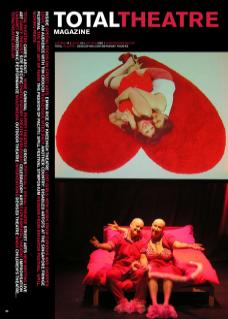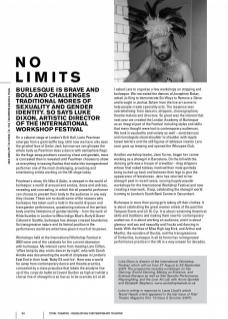On a cabaret stage at London’s Drill Hall, Lazlo Pearlman emerges from a giant duffle bag. Until now we have only seen the grizzled face of Sailor Jack but now we can glimpse the whole body as Pearlman does a dance with semaphore flags. As the flags swap positions covering chest and genitals, more is concealed than is revealed until Pearlman chooses to show us everything in teasing flashes that make this transgendered performer one of the most challenging, provoking and entertaining artists working on the UK stage today.
Pearlman’s show, He Was A Sailor, is steeped in the world of burlesque: a world of arousal and erotica, dress and undress, revealing and concealing, in which the all powerful performer can choose to present their body to the audience in any way they choose. These are no doubt some of the reasons why burlesque has taken such a hold in the world of queer and transgender performance, questioning notions of the perfect body and the limitations of gender identity – from the work of Hilda Eusébio in London to Miss Indigo Blue’s BurlyQ Queer Cabaret in Seattle, burlesque has always crossed boundaries. Its transgressive nature and its liminal position in the performance world are what have given it much of its power.
Workshops held at the International Workshop Festival in 2002 were one of the catalysts for the current obsession with burlesque. My interest came from meeting Lara Clifton, ‘office temp by day; erotic dancer by night’, who with Sarah Ainslie was documenting the world of striptease in London’s East End in their book ‘Baby Oil and Ice’. Here was a world far away from contemporary dance and theatre practice, concealed by a class prejudice that labels the anodyne line up of the corps de ballet at Covent Garden as high art whilst a chorus line of showgirls is so low as to be scarcely art at all.
I asked Lara to organise a few workshops on stripping and burlesque. We recreated the dances of Josephine Baker, asked Jo King to demonstrate Six Ways to Remove a Glove and brought in Joshua Sofaer from the live art scene to help people create speciality acts. The response was overwhelming: from dancers, strippers, choreographers, theatre makers and directors. So great was the interest that next year we created the London Academy of Burlesque as an integral part of the Festival including styles and skills that many thought were lost to contemporary audiences. We took in vaudeville and variety as well – sand dancers and monologists stood shoulder to shoulder with nipple tassel twirlers and the still figures of tableaux vivants. Lara soon gave up temping and opened the Whoopee Club.
Another workshop leader, Jane Turner, began her career working as a showgirl in Barcelona. On the bill with the dancing girls was a troupe of crevettes – drag strippers whose final naked tableau involved their male genitalia being tucked up back and between their legs to give the appearance of femaleness. Jane has returned to her showgirl past in recent years, running hugely popular workshops for the International Workshop Festival and now creating a new work, Troop, celebrating the showgirl world (coming to London’s South Bank Centre in December).
Burlesque is more than young girls taking off their clothes. It is about celebrating the great women artists of the past like Tempest Storm and Lili St. Cyr. It is about reclaiming theatrical skills and traditions and making them new for contemporary audiences. It is about working an audience, and it is about glamour and sex and sexuality and frocks and dancing in heels. With the likes of Miss High Leg Kick, and Arthur and Martha, the wonders of Duckie, and the transgressions of Timberlina, burlesque in all its forms has reinvigorated performance practice in the UK in a way unseen for decades.
Luke Dixon is director of the International Workshop Festival, which will run from 27 August to 26 September 2007. The programme includes workshops on Fan Dancing, Sword Dancing, Making an Entrance, and Erotique Baroque as well as Site Specifc Performance, Playwrighting, and the Love Art Lab with Annie Sprinkle and Elizabeth Stephens. www.workshopfestival.co.uk
Luke is writing in response to Laura Lloyd’s article Tassel Hassle which appeared in the last issue of Total Theatre Magazine (Vol. 19 Issue 2 Summer 2007).

